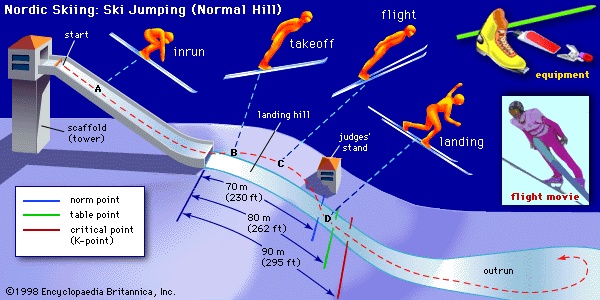ski jumping
sport
 competitive skiing event in which contestants ski down a steep ramp that curves upward at the end, or takeoff point. Skiers leap from the end, trying to cover as much horizontal distance in the air as possible. Ski jumping has been included in the Winter Olympics (Olympic Games) since the 1924 Games in Chamonix, France. Upon addition of a second, much bigger hill to the 1964 Olympics, the event was split, creating large-hill jumping and normal- (or small-) hill jumping. Competitions are held on carefully graded and prepared hills, classed according to the distance from the takeoff point that most skiers could travel and still land safely; most senior international events, including the Olympics, are contested at 120 and 90 m (393.7 and 295.275 ft—large hill and normal hill, respectively). Both individual and team ski-jump events are contested at the Winter Olympics. World championships for ski jumping began in 1925 under the governance of the Fédération Internationale de Ski (FIS), and a World Cup tour was established in 1980. Ski jumping is one of the few sports in which men and women compete in the same events; very few women actually participate in the sport, however, and no woman has ever competed at the Olympic Games in ski jumping.
competitive skiing event in which contestants ski down a steep ramp that curves upward at the end, or takeoff point. Skiers leap from the end, trying to cover as much horizontal distance in the air as possible. Ski jumping has been included in the Winter Olympics (Olympic Games) since the 1924 Games in Chamonix, France. Upon addition of a second, much bigger hill to the 1964 Olympics, the event was split, creating large-hill jumping and normal- (or small-) hill jumping. Competitions are held on carefully graded and prepared hills, classed according to the distance from the takeoff point that most skiers could travel and still land safely; most senior international events, including the Olympics, are contested at 120 and 90 m (393.7 and 295.275 ft—large hill and normal hill, respectively). Both individual and team ski-jump events are contested at the Winter Olympics. World championships for ski jumping began in 1925 under the governance of the Fédération Internationale de Ski (FIS), and a World Cup tour was established in 1980. Ski jumping is one of the few sports in which men and women compete in the same events; very few women actually participate in the sport, however, and no woman has ever competed at the Olympic Games in ski jumping.A ski jump begins with the approach, or inrun, which often starts on a scaffold, or tower; the jumper skis down it in a crouched position accumulating speed (as much as 100 km/hr 【62 mph】) until he reaches the takeoff, where he springs outward and upward. Owing to the risk of traveling downhill at such high speeds and the concurrent possibility of landing too far at the bottom of the hill, judges are given the authority to lower the starting point of a jump in order to decrease the maximum potential speed of jumpers.
Once in the air, competitors can rely only on body position to maximize their jump. Until the early 1990s the preferred position of most jumpers was to lean far forward from the ankles with knees straight and skis held parallel and inclined slightly upward. This position minimizes wind resistance and contributes an aerodynamic lifting effect to increase the length of the jump. In the mid-1980s, however, Swedish jumper Jan Boklöv demonstrated a new technique that provided even more lift: the V style. This position is achieved by pointing the tips of the skis outward in opposite directions to create a V shape. Initially ridiculed for his nontraditional style, Boklöv was later the model for World Cup ski jumpers after his first-place win in the 1988–89 World Cup competition and scientific tests that proved the superior lift gained from the V style.
The landing of a jump is made on a steep section of the hill in a more upright position, with the shock of contact taken up by the knees and hips and one ski farther forward than the other (the telemark position). After the slope levels off, the jumper stops his forward momentum by turning. In addition to the judges' ability to lower the starting point, other precautions are taken to prevent overjumping, including limits on ski length and ski-suit thickness (thicker suits permit more air to be trapped in the suit and allow for longer jumps) and rules for the placement of bindings on skis. The hills have also been altered for safety; hills are now contoured to ensure that a jumper is rarely more than 3 to 4.5 m (10 to 15 ft) above the ground during a jump.
Competitors make two jumps. Performance is decided partly by distance covered and partly by form, on the basis of style marks awarded by five judges. Concerning distance, a jump to the K-point (where the distance from the starting point equals the height of the hill) garners a jumper 60 points, with additional points added for each metre beyond the K-point. Style points are deducted for such errors as touching the ground with a hand after landing or not landing with one foot before the other.
Ski flying is similar to ski jumping in every respect except its scoring system, which emphasizes distance over style. Under ideal conditions top contestants are capable of leaps of over 200 m (656 ft). Ski flying is not included in the Olympics.